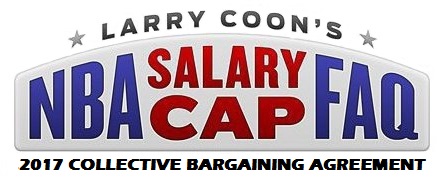
www.cbafaq.com
Copyright © 1999-2022, Larry Coon

www.cbafaq.com
Copyright © 1999-2022, Larry Coon
Click here to go to the most recently published version of the FAQ.
Since first developing CBAFAQ.com in 1999 I have received tremendous support from people in and around the league, from the media, and from the public. I initially had no idea that it would become such a valuable tool for basketball professionals, and that it would become the springboard for a side career that let me experience the league in a way that few are so lucky to experience. I have worked directly with several NBA teams, I have been a credentialled member of the media representing national outlets, and my work has appeared in articles, blogs, podcasts and on television. Iíve developed uncountable relationships within and around the league, and all around the world Ė from the NBAís movers & shakers, to some of my childhood heroes (whoever said you should never meet them was wrong!), to ordinary fans who share the common traits of a curious mind and a love for the game. All this from the humble beginnings of being an ordinary guy who decided to dive into a lengthy, complex legal contract and document what I found.
I consider myself a teacher at heart, and Iím most proud of the opportunities Iíve had to increase the level of knowledge within and around the league, for professionals and fans alike. Most importantly I had a role in helping students open doors to employment in the league, and helped launch many careers with teams, the league office, the media, and related organizations.
As some of you know, I retired from my main career (as a Computer Scientist) in 2024. I did not know what my retirement would mean for my NBA side career. Perhaps my league involvement would increase given my newfound windfall of extra time. Or perhaps it would decrease as new activities took precedence in my life. I decided to let the dust settle and see what happened organically, then reassess after a year or so. Certainly a FAQ update was due for the 2023 CBA, and if it remained a priority for me, then I would find the time to work on it.
Well a year has passed, and I now spend most of my time as a builder and (to a lesser extent) player of acoustic guitars. This is now what sparks my imagination and creativity, and when I get up in the morning I canít wait to get down to my workshop to build and create. Between this, spending additional valuable time with my wife and daughter, and other pursuits around the house my calendar is full Ė I almost canít imagine how I found the time to work 40+ hours a week at my day job, let alone the additional time that my NBA side career took on top of that.
With that, Iíve decided to officially retire from my NBA side career as well, and this includes continuing to maintain CBAFAQ. I will continue to keep the site online and continue to maintain the CBAFAQ.com domain, but Iíll let you decide amongst yourselves who will carry the torch into the future. I donít plan to endorse or support anyone, because I want to let the cream rise to the top.
Thank you to everyone who had a role in the FAQ and in the many facets of my side career. Itís been an honor, a privilege, and a pleasure.
And with that, Iím off to live my best life.
Larry Coon
PS: If you're interested in following my guitar building, you can find me on Instagram at larry_coon_lutherie. Currently I am not selling instruments, but that will change at some point in the near future.